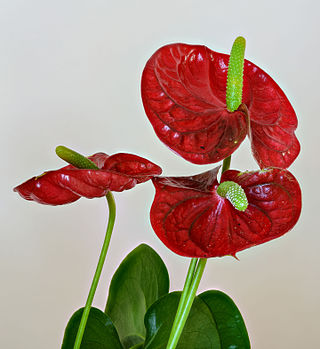
Anthurium is a genus of about 1,000 species of flowering plants, the largest genus of the arum family, Araceae. General common names include anthurium, tailflower, flamingo flower, pigtail plant, and laceleaf.
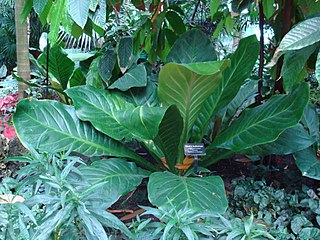
Anthurium hookeri, commonly called a bird's nest anthurium, is a species of flowering plant in the genus Anthurium. Anthurium hookeri possesses some unique features which include, short internodes, dense roots, and lanceolate cataphylls. The leaves have triangular to D-shaped petioles 2–9 cm long, are rosulate, 10–26 cm wide, 35–89 cm long. The leaves exhibit a scalariforme venation and supervolute vernation. Covering the leaves are tiny black glandular punctuates. The berries produced by the plant are white.

The National Botanic Garden of Bangladesh and the Bangladesh National Herbarium make up the largest plant conservation center in Bangladesh, with an area of around 84 hectares. It is located at Mirpur-2 in Dhaka - 1100, beside the Bangladesh National Zoo. It was established in 1961. It is a botanic garden, a knowledge center for nature lovers and botanists and a tourist destination. The herbarium has a scientific collection of approximately 100,000 preserved specimens of plants.

Anthurium andraeanum is a flowering plant species in the family Araceae that is native to Colombia and Ecuador. It is a winner of the Royal Horticultural Society's Award of Garden Merit.

The North Coast Regional Botanic Garden in Coffs Harbour is a 20 hectare oasis in the heart of Coffs blending a mix of natural coastal forests, planted gardens, discovery walks and picnic areas. On Hardacre Street just one km from the Coffs Harbour CBD on the Mid North Coast region of New South Wales, Australia.
Dialyceras coriaceum is a tree in the family Sphaerosepalaceae. It is endemic to Madagascar.
Thomas Bernard Croat is an American botanist and plant collector, noteworthy as one of botanical history's "most prolific plant collectors". He has collected and described numerous species of plants, particularly in the family Araceae, in his career at the Missouri Botanical Garden.
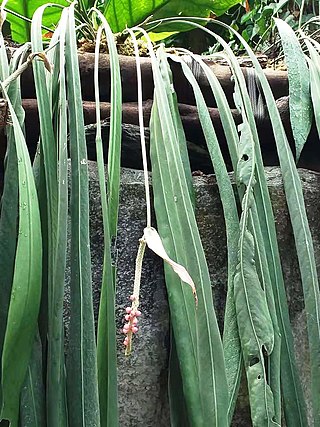
Anthurium vittariifolium is a species of flowering plant in the genus Anthurium native to the Amazon basin; southeast Colombia, Ecuador, Peru, and northern Brazil. With its long, pendulous leaves that can reach 2.4 m (8 ft), it is among those commonly known as "strap-leaved" anthuriums. It grows as an epiphyte at lower elevations of tropical moist forests, and is a member of the section Leptanthurium along with Anthurium gracile.
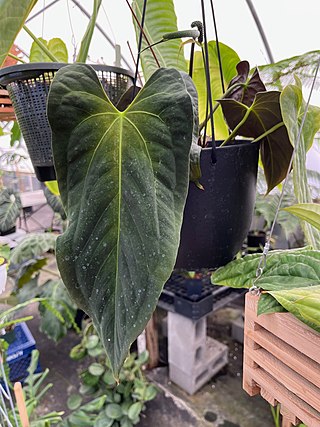
Anthurium papillilaminum is a species of plant in the genus Anthurium native to Panama. A. papillilaminum grows terrestrially and has very dark green cordate leaves on short stems. Its native range is very limited, with the species endemic to only the coasts of Colón Province and Darién Province up to 100 meters (330 ft) above sea level. A member of the section Cardiolonchium, it is closely related to other velvet-leaved Anthuriums, though it does not have silver veins on the leaves like Anthurium crystallinum.

Anthurium corrugatum is a species of plant in the genus Anthurium native to Central and South America from Panama to Ecuador. This species is noted for its cordate leaves with a network of fine veins that gives it a bullate appearance. A terrestrial grower, it is adapted to cool, humid climates. It is a member of the section Polyneurium along with Anthurium argyrostachyum and others.

Anthurium podophyllum is a species of plant in the genus Anthurium native to coastal areas of the Mexican states of Veracruz and Oaxaca. A terrestrial species, it grows in tropical forest understories in seasonally dry areas. It is named for its palmate leaves that somewhat resemble plants in the (unrelated) genus Podophyllum, and which have many subdivisions. It is related to other terrestrial Anthurium with similar leaf morphology in the section Schizoplacium, such as Anthurium pedoradiatum, and produces orange berries.

Anthurium jenmanii is a species of plant in the genus Anthurium. Growing as an epiphyte subshrub, it is native to South America from Trinidad and Tobago to Brazil. A member of the section Pachyneurium, and like related species it has a "birds nest" growth habit. It has a dark purple-black spadix and spathe, and produces red berries. In cultivation, it is commonly mistaken for Anthurium bonplandii subsp. guayanum, a related species.

Anthurium bonplandii is a species of plant in the genus Anthurium native to South America. A member of the Anthurium sect. Pachyneurium, it grows terrestrially or occasionally epiphytic or epilithic. It is often confused with Anthurium jenmanii when young and Anthurium atropurpureum.

Anthurium ernestii is a species of plant in the genus Anthurium native to South America. Found from southern Colombia to Peru and western Brazil, it typically grows below 500 metres (1,600 ft).

Anthurium argyrostachyum is a species of plant in the genus Anthurium native to Ecuador and Colombia. Growing as a small shrub or an epiphyte, it is best recognized by its foliage that has triangular or arrowhead-like shape, a long central lobe, and parallel veins. It is a member of the section Polyneurium, and is thus related to Anthurium corrugatum, Anthurium panduriforme, and others that share its parallel venation and other characteristics.

Anthurium dwyeri is a species of plant in the genus Anthurium native from Costa Rica to the Chocó Department of Colombia. Named in honor of the botanist Dr John D. Dwyer, it has no known close relatives but is a member of the section Porphyrochitonium. An epiphyte, it is most easily recognizable by its leathery, oblong to elliptical leaves that are 24–40 centimetres (9.4–15.7 in) long and grow on triangular stems.

Anthurium coloradense is a species of plant in the genus Anthurium native to Panama. A member of the section Polyneurium, this terrestrial shrub is most recognizable by its thin, veined leaves and its yellow-green spadix. Its foliage is very similar to other Panamanian species such as Anthurium caperatum, Anthurium santamariae and Anthurium cerrosantiagoense but may be distinguished by details such as the grooves in its stems and the pattern of veining, with the collective vein growing from the third vein in a leaf.

Anthurium marmoratum is a species of plant in the genus Anthurium native to western Colombia and Ecuador. It is a member of the section Cardiolonchium, or the velvet-leaved Anthuriums, along with A. papillilaminum, A. regale, A. crystallinum, and others. It is one of many species used by curanderos in South America to treat snakebite.

Anthurium wendlingeri is a species of aroid plant, in the genus Anthurium, found from Central to South America, from SE Nicaragua to NW Colombia. It grows in moist, montane tropical habitats as an epiphyte. Unique among its genus, A. wendlingeri has long, pendant and strap-like leaves, and can have a slightly velvety appearance.
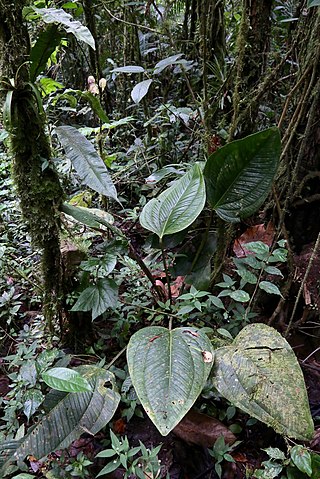
Anthurium ovatifolium is a species of plant in the genus Anthurium native to Colombia, Ecuador, and Peru. It grows in wet tropical habitats, and is a member of the section Digitinervium. Its species name refers to the oval shape of its leaves, and it can be distinguished from similar species like Anthurium lentii by its red berries.


















